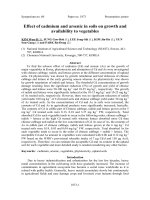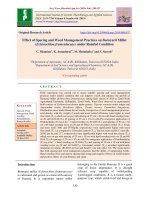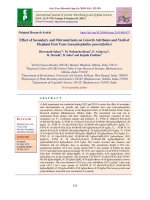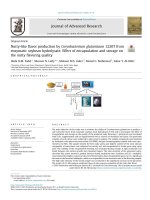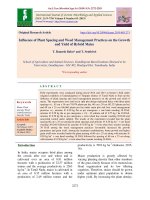Effect of tillage and weed management practices on weed dynamics and productivity in maize (Zea mays)-wheat (Triticum aestivum) system
Bạn đang xem bản rút gọn của tài liệu. Xem và tải ngay bản đầy đủ của tài liệu tại đây (213.59 KB, 7 trang )
Int.J.Curr.Microbiol.App.Sci (2017) 6(4): 1907-1913
International Journal of Current Microbiology and Applied Sciences
ISSN: 2319-7706 Volume 6 Number 4 (2017) pp. 1907-1913
Journal homepage:
Original Research Article
/>
Effect of Tillage and Weed Management Practices on Weed Dynamics and
Productivity in Maize (Zea mays)-Wheat (Triticum aestivum) System
Lobzang Stanzen*, Anil Kumar, R. Puniya, Neetu Sharma, Ashu Sharma,
Amit Mahajan and Ramesh Chand Bana
Department of Agronomy, Sher-e-Kashmir University of Agriculture Science
and Technology, FOA Chatha, Jammu-180009, India
*Corresponding author
ABSTRACT
Keywords
Maize,
Wheat, Tillage,
Weed Density,
Weed biomass.
Article Info
Accepted:
15 March 2017
Available Online:
10 April 2017
An investigation was carried out at Sher-e-Kashmir University of Agriculture Science and
Technology of Jammu during 2013-14 and 2014-15, to assess the influence of 4 tillage
systems and 3 weed-control practices on weed dynamics and productivity in maize-wheat
cropping sequence. In maize, grain yield of maize was statistically at par in continuous
conventional tillage (CT-CT) in both maize and wheat and conventional tillage in maize
and zero tillage in wheat (CT-ZT). Different tillage treatments did not influence on weed
density, weed biomass, plant growth characters, grain and straw yields of wheat in maizewheat cropping sequence. Amongst the weed-control practices, 2 hand weedings which
was at par with atrazine (1 kg/ha) in maize and metribuzin (200 g/ha) at par with two hand
weedings in wheat which was significantly reduced weed density, weed biomass and
recorded significantly higher maize and wheat grain and straw yields than weedy check.
Introduction
Maize (Zea mays L.) and wheat (Triticum
aestivum L.) are the two important staple food
crops of India which provide food security to
the country’s population. These crops are
grown in almost all the pockets of the country
either in irrigated or rainfed conditions but the
productivity is higher in irrigated ecosystems
which are mainly situated in Indo-gangetic
plains.
At present the soil, a natural resource is under
great amount of stress owing to intensive
cropping with a rising of more than two crops
in a year without replenishing this resource as
in desirable. Repeated conventional tillage
coupled with other faulty land utilization
practices have caused large scale degradation
of our soils over the past 50-60 years and
most of the soils have lost up to one-half of
their native organic matter content and micro
fauna (Malik et al., 2006). Hence, zero tillage
is one of the better options that reduce the
problems associated to certain extent.
However, a combination of zero and
conventional options in sequence need to be
standardized for each cropping, soil and
microclimatic conditions in order to enhance
the sustainability of systems and resource use
efficiency. Zero tillage improves physicchemical and biological properties of soil and
reduces the cost of production (Bisen and
Singh, 2008; Jha et al., 2011). Hence, present
1907
Int.J.Curr.Microbiol.App.Sci (2017) 6(4): 1907-1913
study was conducted to assess the effect of
tillage and weed management practices on
weed dynamics and productivity in maize
(Zea mays)- wheat (Triticum aestivum)
system.
density and biomass were subjected to square
root transformation √x+1 to normalize their
distribution. WCE was calculated by using the
formulae suggested by Mishra & Mishra
(1997).
Materials and Methods
Results and Discussion
A field experiment was carried out during
rabi season of 2013-14 and 2014-15 at Shere-Kashmir University of Agriculture Science
& Technology of Jammu. The experimental
soil was sandy clay loam in texture with
slightly alkaline in reaction (pH 7.87),
medium in organic carbon (0.52 %), available
phosphorus (12.32 kg/ha) and potassium
(148.4 kg/ha) and low in available nitrogen
(247.60 kg/ha). The experiment was
conducted in split-plot design with three
replications. The main plot comprised of four
tillage treatments, viz. continuous zero tillage
in maize-wheat (ZT-ZT), zero tillage in maize
and conventional tillage in wheat (ZT pb CT),
conventional tillage in maize and zero tillage
in wheat (CT pb ZT) and continuous
conventional tillage in maize-wheat sequence
(CT pb CT), whereas, sub-plot comprised of
three weed management practices, viz. hand
weedings (two), weedy check and atrazine at
1 kg/ha in maize and metribuzin at 200 g/ha
in wheat. Maize variety ‘Kanchan 517’ was
sown on 16 June 2013 with seed rate 20 kg/ha
at row to row spacing of 60 cm and plant to
plant spacing of 20 cm and wheat variety
‘RSP 561’ was sown on 15 November, 2013
with 100 kg seed/ha at row to row spacing of
20 cm. Post-emergence application of
herbicide were sprayed by knap sack sprayer
fitted with flat fan nozzle using a spray
volume of 500 lt/ha. Weedy check plots
remained infested with native population of
weeds till harvest. The weeds removed from
the selected areas were dried at 65oC to obtain
constant weight and the weight was expressed
in g/m2. Data on weed density and biomass
were taken by quadrate method. The weed
The predominant weed flora in maize
comprised of Cyperus rotundus among
sedges, Cynodon dactylon, Echinochloa
crusgalli, Setaria glauca among grassy
weeds, Amaranthus viridis and Celosia
argentea were broad leaved weeds, whereas
the dominant weed flora of the wheat
experimental field was Medicago denticulata,
Anagallis arvensis, Cirsium arvense and
Chenopodium album amongst broad leaved
weeds and grassy weeds included Phalaris
minor and Poa annua.
Weed density and biomass
Results presented in table 1 clearly indicated
that continuous zero tillage (ZT) in both the
crops significantly increased the weed density
and biomass in maize which is statistically at
par with zero tillage in maize and
conventional tillage in wheat (ZT-CT) in
maize-wheat cropping and lowest weed
density and biomass was observed in
continuous conventional tillage (CT-CT).
Whereas in wheat, different tillage systems
under test did not differ significantly for their
effect on weed density and biomass.
Among the different weed management
treatments in maize, significantly lower
number of total weed density and biomass
was noted in treatment of two hand weedings
but was at par with treatment atrazine 1 kg/ha.
In wheat, among the weed managements
treatments, significantly lowest weed density
and biomass was recorded in metribuzin at
200 g/ha which was at par with two hand
weeding.
1908
Int.J.Curr.Microbiol.App.Sci (2017) 6(4): 1907-1913
Table.1 Influence of different tillage and weed management on weed density and weed biomass at
harvest in maize-wheat cropping sequence of 2013-14
Weed density (No./m2)
Treatments
Weed biomass (g/m2)
Weed control efficiency (%)
Maize
Wheat
Maize
Wheat
Maize
Wheat
At harvest
120 DAS
At harvest
120 DAS
At harvest
120 DAS
9.43
(93.56)
9.14
(88.22)
8.31
(75.44)
8.14
(72.67)
9.16
(90.22)
9.06
(88.78)
8.87
(86.44)
8.89
(86.56)
12.40
(166.44)
12.21
(162.78)
11.43
(146.11)
11.23
(141.67)
11.56
(142.67)
11.50
(140.33)
11.36
(138.56)
11.22
(136.11)
44.48
43.35
45.71
44.27
51.27
44.98
52.74
45.95
SEm±
0.09
0.09
0.06
0.11
-
-
CD (p=0.05)
0.31
NS
0.21
NS
-
-
6.83
(46.33)
7.12
(50.25)
12.32
(150.83)
7.11
(49.83)
6.89
(46.58)
12.98
(167.58)
8.92
(79.08)
9.19
(83.83)
17.34
(299.83)
9.32
(86.17)
9.01
(80.25)
15.90
(251.83)
73.62
65.78
72.04
68.13
-
-
SEm±
-
0.08
0.09
0.12
-
0.10
CD (p=0.05)
-
0.25
0.28
0.36
-
0.30
Tillage
ZT-ZT
ZT-CT
CT-ZT
CT-CT
Weed management
2 hand weeding
Atrazine (1 kg/ha)*/
Metribuzin (200 g/ha)**
Weedy check
1909
Int.J.Curr.Microbiol.App.Sci (2017) 6(4): 1907-1913
Table.2 Influence of different tillage and weed management on growth character of maize and wheat crop in maize-wheat cropping
sequence of 2013-14
Growth and yield attributes of maize at
harvest
Growth and yield attributes of wheat at 120 DAS
Treatments
Plant height
(cm)
Leaf Area
Index
No. of
cobs/plant
Plant height
(cm)
Leaf Area
Index
No. of
earheads/m2
ZT-ZT
185.89
2.83
1.35
96.44
2.56
285.67
ZT-CT
186.44
2.93
1.36
97.22
2.67
285.78
CT-ZT
188.89
3.43
1.47
99.78
2.89
287.67
CT-CT
189.78
3.48
1.48
101.00
3.00
288.22
SEm±
0.76
0.03
0.17
1.14
0.17
2.75
CD (p=0.05)
2.64
0.10
NS
NS
NS
NS
2 hand weeding
190.33
3.33
1.54
98.92
2.83
285.67
Atrazine (1 kg/ha)*/ Metribuzin
(200 g/ha)**
189.33
3.29
101.50
3.25
287.92
Weedy check
183.58
2.88
1.28
95.42
2.25
286.92
SEm±
0.59
0.02
0.16
0.89
0.23
4.69
CD (p=0.05)
1.75
0.06
NS
2.66
0.69
NS
Tillage
Weed management
1.47
Maize*, Wheat **
1910
Int.J.Curr.Microbiol.App.Sci (2017) 6(4): 1907-1913
Table.3 In Influence of different tillage and weed management on yield and harvest index of maize and wheat in maize-wheat
cropping system 2013-14
Yield (kg/ha)
Treatments
Maize
Harvest Index
Maize
Wheat
Wheat
Grain
Stover
Grain
Straw
3145
3267
3640
3851
61.19
211.74
8830
9073
9813
10237
129.24
447.22
3147
3157
5803
5811
3325
5996
3336
64.54
NS
4010
10624
3899
2519
93.67
280.83
Tillage
ZT-ZT
ZT-CT
CT-ZT
CT-CT
SEm±
CD (p=0.05)
Weed management
2 hand weeding
Atrazine (1 kg/ha)*/
Metribuzin (200 g/ha)**
Weedy check
SEm±
CD (p=0.05)
6017
138.16
NS
26.09
26.32
26.92
27.20
0.10
0.34
34.54
34.61
34.95
34.96
0.75
NS
3850
6607
27.36
36.88
10479
3958
6699
27.10
37.15
7362
218.69
655.62
1916
68.27
204.67
4414
155.95
467.55
25.45
0.20
0.61
30.28
0.63
1.90
Maize*, Wheat **
1911
Int.J.Curr.Microbiol.App.Sci (2017) 6(4): 1907-1913
The improvement in density of grassy weeds
might be due to higher deposition of seed in
upper layer of soil (0-10 cm) with no
disturbance of the top soil. However, under
continuous conventional tillage and rotated
tillage lower grassy weed density could be
ascribe to comparatively less number of seeds
of this category on top 0-10 cm layer of soil
due to burying of seed into deeper layer and
killing of newly emerged weeds with repeated
tillage operation, viz. ploughing, harrowing
and cross cultivator (Mahajan et al., 2002).
Among the different tillage treatments CT-CT
recorded highest weed control efficiency in
both maize and wheat crop followed by CTZT treatment and among the weed control
treatments in maize two hand weeding
recorded highest weed control efficiency
followed by Atrazine at 1 kg/ha. Shah and
Koul (1990) and Thakur (1994) also observed
higher WCE under twice hand weeding.
Whereas, in wheat, highest weed control
efficiency was observed in Metribuzin @ 200
g /ha followed by two hand weedings.
better interception, absorption and utilization
of radiant energy, thereby resulting in higher
photosynthesis and finally growth parameters
(Bisen and Singh, 2008.)
Growth parameters and Yield attributes
Yields
In maize, the highest plant height and leaf
area under continuous conventional tillage
(CT-CT) which was at par with rotated
conventional tillage in maize and zero tillage
in wheat (CT-ZT) (Table 2). However,
different tillage systems under test did not
differ significantly for their effect on number
of cobs/plant in maize and plant height, leaf
area and number of ears head/m2 in wheat
crop. The improvement in plant height and
leaf area of maize under continuous
conventional tillage (CT-CT) and rotated
conventional tillage in maize and zero tillage
in wheat (CT-ZT) in maize-wheat system
seems to be due to better tilth, aeration,
improved water-holding capacity of soil,
better root growth and its proliferation, which
might have promoted growth of leaves by
virtue of enhanced cell-division and increased
The highest grain yield and stover yield of
maize was recorded under continuous
conventional tillage (CT-CT), which was at
par with rotated (CT-ZT) in maize-wheat
cropping sequence, but was significantly
higher over zero tillage in maize and
conventional tillage in wheat (ZT-CT) and
continuous zero tillage (ZT-ZT). But in wheat
different tillage systems failed to recorded
perceptible variation in grain yield and straw
yield. But maximum harvest index was
recorded under (CT-CT) followed by (CTZT) in both crops. The weed-control
treatments recorded significantly higher grain
yield, stover yields and harvest index than
unweeded check. Two hand weeding at 15
and 30 days after sowing produced
significantly higher maize grain yield, stover
yield and harvest index and statistically on a
Among the different weed management
treatments highest plant height and leaf area
in maize found under two hand weedings,
were at par with atrazine at 1 kg/ha and both
of these proved significantly superior to the
weedy check. Whereas in wheat highest plant
height and leaf area recorded under
metribuzin at 200 g/ha were at par with two
hand weedings. The better growth parameters
were owing to significant reduction in weed
density and dry matter of weeds under
treatments
of
hand
weedings
and
recommended herbicides in both crops,
indirectly it might be on account of results of
better plant growth, greater penetration of
solar radiation in the crop canopy, which can
be reason for greater rate of photosynthesis
and more accumulation of dry matter and crop
growth rate (Singh et al., 2010).
1912
Int.J.Curr.Microbiol.App.Sci (2017) 6(4): 1907-1913
par with Atrazine at 1 kg/ha. In wheat
metribuzin at 200 g/ha recorded significantly
higher grain, straw yield and harvest index
and statistically on a par with two hand
weedings at 30 and 60 days after sowing.
These findings are in line with the results of
Sharma et al., (1998) for atrazine 1.5 kg/ha
(Table 3).
References
Bisen, P.K. and Singh, R. 2008. Effect of
tillage and weed control practices on
weed growth and yield of wheat
(Triticum aestivum) - rice (Oryza
sativa) system. Indian J. Agri. Sci.,
78(4): 347-50.
Jha, A.K., Kawat, M.L., Upadhyay, V.B. and
Vishwakarma, S.K. 2011. Effect of
tillage and sowing methods on
productivity, economics and energetic
of rice (Oryza Sativa)-wheat (Triticum
aestivum) cropping system. Indian J.
Agronomy, 56(1): 35-40.
Mahaja, G., Brar, L.S. and Walia, U.S. 2002.
Phalaris mino response in wheat in
relation to planting dates, tillage and
herbicides. Indian J. Weeds Sci., 34(1
and 2): 114-15.
Malik, R.K., Yadav, A. And Kamboj, B.R.
2006. Conservation tillage and crop
establishment techniques. (In:) Abstract
Golden Jubilee National Symposium on
Conservation
Agriculture
and
Environment, held during October 2628, Banaras Hindu University, p. 11-16.
Mishra, M. and Mishra, A. 1997. Estimation
of integrated pest management index in
Jute-A new approach. Indian J. Weed
Sci., 29(1&2): 39-42.
Shah, M.H. and P.K. Kour. 1990. Fertilizer
and herbicide compatibility to control
weeds in maize under moisture stress
conditions. Annals Agri. Res., 11: 21.
Sharma, A.R., Toor, A.S. and Sur, H.S.2000.
Effect of interculture operations and
scheduling of atrazine application on
weed control and productivity of rainfed
maize (Zea mays) in Shivalik foothills
of Punjab. Indian J. Agri. Sci., 70: 757761.
Singh, G., Singh, O.P., Singh, S. and Prasad,
K. 2010. Weed management in late
sown wheat (Triticum aestivum) after
rice (Oryza sativa) in rice-wheat system
in rainfed lowland. Indian J. Agronomy,
55(2): 88.
Thakur, D.R. 1994. Weed management in
intercropping systems based on maize
under rainfed mid Hill condition. Indian
J. Agronomy, 39: 203.
How to cite this article:
Lobzang Stanzen, Anil Kumar, R. Puniya, Neetu Sharma, Ashu Sharma, Amit Mahajan and
Ramesh Chand Bana. 2017. Effect of Tillage and Weed Management Practices on Weed
Dynamics and Productivity in Maize (Zea mays)-Wheat (Triticum aestivum) System.
Int.J.Curr.Microbiol.App.Sci. 6(4): 1907-1913. doi: />
1913
